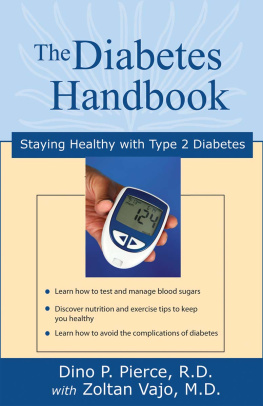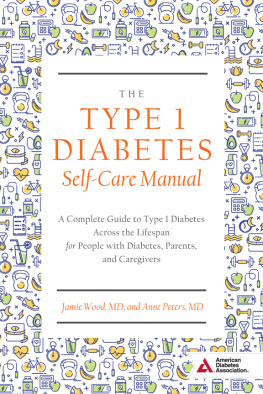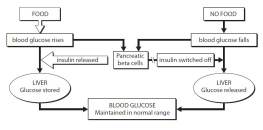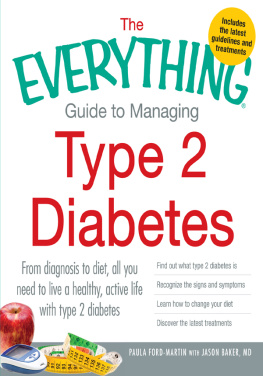Table of Contents
Other books by June Biermann and Barbara Toohey
The Peripatetic Diabetic
The Diabetes Question and Answer Book
The Diabetes Sports and Exercise Book
(with Claudia Graham, CDE, MPH, Ph.D.)
The Diabetics Book: All Your Questions Answered
The Diabetic Woman
(with Lois Jovanovic-Peterson, M.D.)
The Diabetic Man
(with Peter A. Lodewick, M.D.)
The Diabetics Total Health Book
Psyching Out Diabetes: A Positive Approach to Your Negative Emotions
(with Richard R. Rubin, Ph.D., CDE)
The Stroke Book: A Guide to Life After Stroke for Survivors
and Those Who Care for Them
I dedicate this book to my late mother, Myrna Valentine, who was a type 2 diabetic and the epitome of what every nurse should be; to my late father, Jay Valentine, a truly nice man; to my daughter, Melanie, who has type 2 diabetes and who I hope will grow up in a world without suffering from diabetes; and to the worlds best husband, John McLaughlin.
V.V.
Dedicated to diabetes visionary Michael Reynolds for his wit and perspicacity, but most of all for his enduring friendship.
J.B. and B.T.
Foreword
IT IS DIFFICULT TO OPEN A MAGAZINE OR A NEWSPAPER without reading that rates of obesity and diabetes are on the rise in the United States and throughout the world. Yet when diabetes is diagnosed in an individual, the facts and figures about the epidemic recede and it becomes a deeply felt, personal issue. Because of its genetic nature, many who develop type 2 diabetes have already seen family members struggle with it, some succumbing to its devastating (but now often preventable) complications. In addition, diabetes, perhaps more than any other chronic disease, conjures up feelings of guilt: guilt for being overweight or for being physically unfit; guilt for staying in denial just a little too long; and for many, worst of all, the guilt that diabetes has been passed on to the next generation.
Much of what is written about diabetes lacks connection with the true feelings experienced by people who have diabetes. When I completed my fellowship in endocrinology, in the late 1980s, I came across a book titled The Diabetic Woman by Lois Jovanovic, June Biermann, and Barbara Toohey. I have intense admiration for these woman, whose book is the first Id ever read that taught me the human side to having diabetes. Now, two of those three authors, June and Barbara, have teamed up with Virginia Valentine, diabetes expert and a person with diabetes, to create an essential guide for dealing with type 2 diabetes. Their unique voices and easily readable style, along with practical advice and engaging patient stories, create a narrative that relates to the person with diabetes. This team is able to take the overwhelming facts and figures about diabetes and turn them into a recipe for daily life.
Everyone with diabetes, whether newly diagnosed or a long-term veteran, will benefit from reading Diabetes: The New Type 2. So, too, will family and friends whose lives are also touched by the disease. The good news is that this book, providing caring guidance from three special women, can help people with type 2 diabetes live long and healthy lives, free of complications. All it takes is a commitment to health and a willingness to learn. That and three wise women named June, Barbara, and Virginia, who can help you find a way to reach your goals.
Anne L. Peters, M.D., CDE
Director, USC Clinical Diabetes Programs
Professor, USC Keck School of Medicine
How to Use This Book
Three for the Road to Understanding Type 2 Diabetes
YOU ARE ABOUT TO GET ACQUAINTED WITH US AND OUR modus operandi in this book, but heres a hint of things to come.
June and Barbara have labored as a team over lo these many years, writing on many and varied topics, but primarily on matters diabetic. They continue in this collaborative mode while batting diabetes problems and solutions back and forth with Virginia.
Virginia is widely considered a learned diabetes health-care professional because thats what she is, and she has all the requisite initials after her nameas well as the national and international speaking appearancesto prove it. Also, as you will soon notice, she is by nature an indomitable spirit raiser with a sense of humor that defies depression.
So now that you know where were coming from, lets get going.
Introduction
The Worst of Times, The Best of Times
TO PARAPHRASE A TALE OF TWO CITIES, WEVE BEEN THROUGH the worst of times and the best of times for type 2 diabetes.
The Worst of Times
Back in the dark ages of diabetes, when June was diagnosed, nobody really understood diabetesand that included many doctors. June was over forty when she was told she had type 2. She was given the standard treatment for type 2 in those days, which was a casual watch your diet, cut out sweets, lose a few pounds, get a little more exercise, and youll be just fine. June was a person who had always been on the verge of being underweight, who was careful about following a healthful diet and never cared for sweets, and who was a serious walker and bike rider. Even so, she tried to follow the doctors advice. The result was she lost weightactually almost wasted awayand eventually had to be put on insulin to help her gain some sorely needed pounds.
From this youve probably guessed that despite her age category June turned out to have type 1 diabetes. She was insulin-deficient, meaning her body didnt produce enough insulin. She was not a type 2 like you, whose body produces plenty of insulin but cant use it effectively. More about this later, but suffice it to say that back then, many people like June had to suffer through periods of misdiagnosis.
The Best of Times
Gradually, health professionals learned about type 1 and type 2 diabetes and the profound differences between them. Consequently, more and more physicians and nurses and dietitians went into the field to help affected people know what kind of diabetes they had and how to appropriately care for it in order to live a long and happy life. And as pharmaceutical companies came to realize that there was a growing market for products and devices to help keep diabetes in good control, they became willing to invest heavily in the research and development of these products and devices. Things were clearly getting better for diabetics.
The Worst of Times and the Best of Times
But no one could call a period like the one were in now as a total best of times. Growing numbers of people in the United States have diagnosed cases of diabetes, and untold others are running around undiagnosed, while diabetes, silently and slowly but surely, wreaks physical havoc on them.
Another aspect of diabetes is turning out to be the worst of the worst, as children and young people are developing type 2 diabetes as never before. But take heart. Were not going to let diabetes sneak up on us as it has in the past. Everyone is becoming more aware of diabetes and is determined to do something about it now. We know it can and will happen. In fact, one of the movers and shakers in making things happen in type 2 diabetes is our collaborator, Virginia Valentine.














